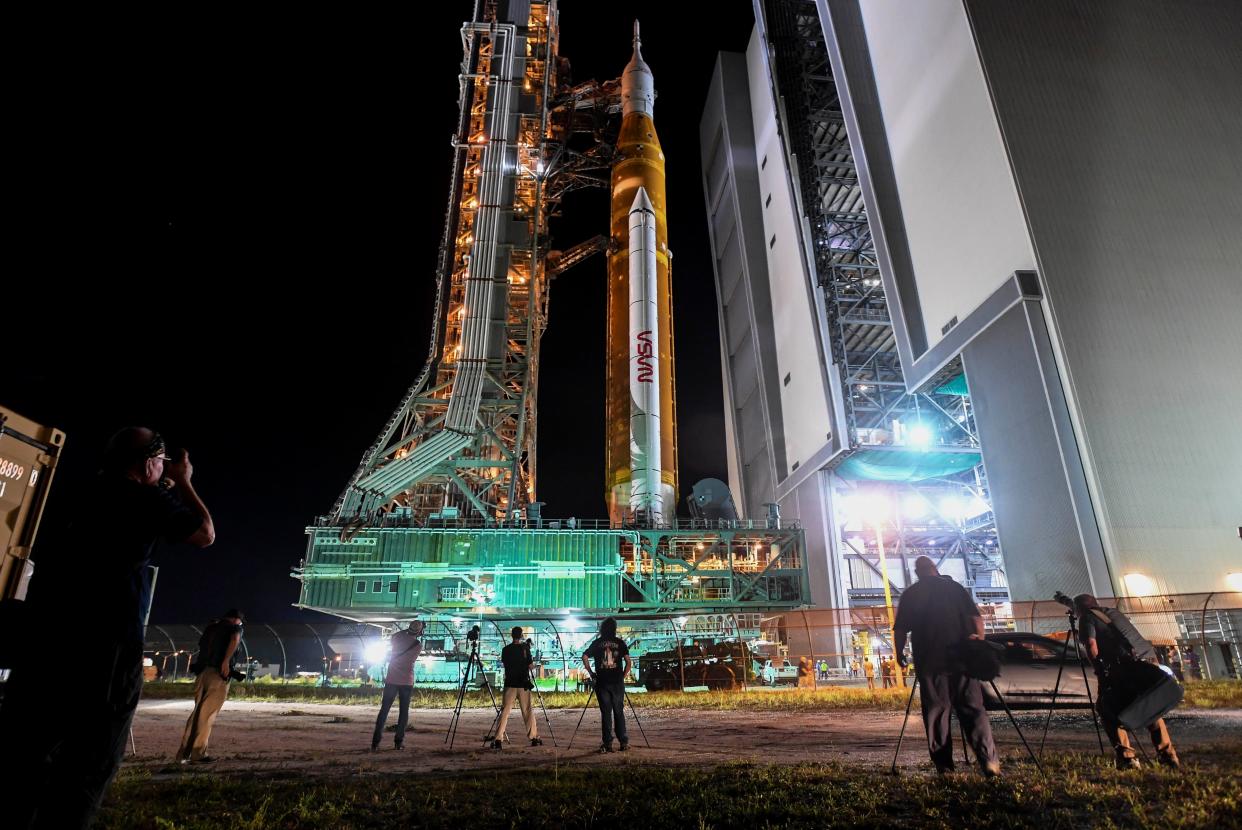NASA rolls massive Artemis I moon rocket to Florida pad ahead of historic launch

Space is important to us and that’s why we're working to bring you top coverage of the industry and Florida launches. Journalism like this takes time and resources. Please support it with a subscription here.
---
A new NASA-branded rocket destined for the moon later this month rolled out of its historic home at Kennedy Space Center late Tuesday, kicking off the first leg of its weeks-long mission for the agency's Artemis program.
Just before 10 p.m. EDT, a crawler-transporter slowly moved the massive 322-foot Space Launch System rocket out of the Vehicle Assembly Building and set out on a roughly four-mile trek to pad 39B. The rollout was initially planned for 9 p.m. but had to be pushed back due to lightning in the area.
After several planned stops along the way, SLS arrived around 7:30 a.m. Wednesday as teams prepared for the process of lowering the mobile launcher. NASA calls 39B a "clean pad," meaning the rocket's support structures like the tower are transported with it instead of permanently standing at the launch complex.
Crawler-Transporter 2, a behemoth tracked vehicle left over from the Apollo and space shuttle programs, reached a top speed of 0.82 mph on the path from the VAB to 39B.
A few hundred people – KSC employees and their families and friends, officials, media, and more – watched the rollout from several designated spots around the VAB. Launch day crowds are expected to draw at least 100,000 visitors to the Space Coast – that's on top of the thousands already expected to travel here to support the launch.
More: NASA’s big gamble: Is new rocket too costly to launch us back to the moon?
More: Big rocket, big cost: Can NASA afford the SLS?
SLS' mission: Artemis I, its debut flight that will take an uncrewed Orion capsule to the moon and back. Liftoff is slated for 8:33 a.m. EDT Monday, Aug. 29, and includes backup windows on Sept. 2 and Sept. 5. Mission managers will arrive at their Launch Control Center consoles 46 hours before launch to start powering up and preparing for fueling operations.
From launch to splashdown, the mission should run just over 42 days.
If all goes according to plan, that will pave the way for Artemis II, which will do much the same in 2024 but with astronauts. Then Artemis III is expected to put two astronauts on the surface of the moon sometime after 2025.
Beyond that, NASA hopes to use the moon as a place to conduct research, mine for resources, and push onward to deep space destinations like Mars.
The late August launch is more than a decade in the making. Despite using leftover space shuttle hardware like RS-25 main engines, the SLS rocket and Orion capsule are billions over budget and years behind schedule. NASA says funding levels pale in comparison to other programs like Apollo; core stage contractor Boeing also played a role in delays and cost overruns. Lockheed Martin, meanwhile, is responsible for the Orion capsule.
For the latest, visit floridatoday.com/launchschedule.
Contact Emre Kelly at aekelly@floridatoday.com or 321-242-3715. Follow him on Twitter, Facebook and Instagram at @EmreKelly.
Launch Monday, Aug. 29
Rocket: NASA Space Launch System
Mission: Artemis I
Launch Time: 8:33 a.m. EDT
Launch Pad: 39B at Kennedy Space Center
Duration: 42 days
Visit floridatoday.com/space at 5 a.m. Monday, Aug. 29, for real-time updates and live video.
This article originally appeared on Florida Today: NASA rolls Artemis I moon rocket to Florida pad ahead of launch

